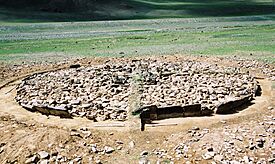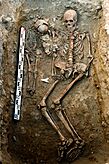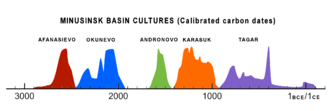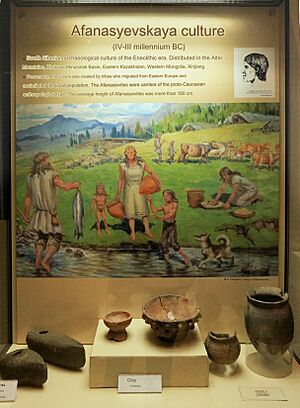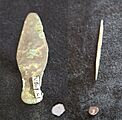Afanasievo culture facts for kids
| Alternative names | Afanasevo culture; Afanasevans |
|---|---|
| Geographical range | South Siberia |
| Period | Bronze Age |
| Dates | 3300 BCE — 2500 BCE |
| Type site | Gora Afanasieva (Minusinsk Basin) |
| Followed by | Chemurchek culture, Okunev culture, Karakol culture, Andronovo culture, Deer stones culture |
The Afanasievo culture was an early group of people who lived in South Siberia. They were active during the Bronze Age, from about 3300 to 2500 BCE. Their main areas were the Minusinsk Basin and the Altai Mountains. This culture is named after a nearby mountain called Gora Afanasieva in Khakassia, Russia.
Archaeologists first studied the Afanasievo culture in the 1920s. Their burial sites have been found far away, even in central Mongolia. This shows that the Afanasievo people spread out quite a lot. Experts believe they came from people who moved across the Eurasian Steppe from the Don-Volga region. They brought new ways of life to Siberia.
Some scholars think the Afanasievo people might be linked to the ancient Tocharian language. Their genetic traces lasted in some areas for a long time.
Contents
Archaeological Sites
(Altai Mountains)
(Central Mongolia)
The first Afanasievo site was discovered near Gora Afanasieva. Russian archaeologist Sergei Teploukhov excavated it between 1920 and 1929. This is how the culture got its name. The original site is now underwater due to a reservoir built in the 1960s.
Many other Afanasievo sites have been found. These include areas like the Ukok Plateau and even as far south as Ürümqi in Dzungaria. Recently, burials were found in central Mongolia, showing they spread far to the east.
Dating the Culture
At first, archaeologists thought the Afanasievo culture existed from 2500 to 2000 BCE. But new methods, like Radiocarbon dating, showed it started much earlier. Now, we know the culture began around 3300 BCE and ended around 2500 BCE.
Culture and Lifestyle
The Afanasievo people usually buried their dead in single or small family graves. The bodies were often placed on their backs with knees bent. These burial pits were often surrounded by stone walls. It seems these were family burial spots.
The Afanasievo people were the first to raise animals for food in this region. They herded cattle, sheep, and goat. They also had horses, though we don't know if they were wild or tamed. They used tools made from stone, bone, and animal antlers. Some antler pieces might have been used with horses. Pictures found in the area suggest they used wheeled vehicles.
They also used metals like copper, silver, and gold for ornaments. The Afanasievo people were important for bringing animal herding and early metalworking to Inner Asia. They used copper and bronze to make tools like awls and knives. They might have used wagons pulled by cattle, similar to other ancient groups.
Gallery
-
Bronze knife and bronze awl from the Afanasievo burial of Khuurai Gobi, Bayan-Ölgii Province, 3000 BCE. National Museum of Mongolia.
Ancient Rock Art
Rock carvings, called petroglyphs, from the Afanasievo period show animals. These carvings are similar to others found in western and central Asia.
-
Animal hunting, 3000 BCE, Arkhangai Province, Mongolia. National Museum of the Altai Republic
-
Animal hunting, 3000 BCE, Övörkhangai Province, Mongolia. National Museum of the Altai Republic
-
Animal hunting, 3000 BCE, Mongolia. National Museum of the Altai Republic
Genetics
Studies of ancient DNA show that the Afanasievo people were very similar to the Yamnaya culture from the Pontic–Caspian steppe. This suggests that the Afanasievo culture arrived in the Altai region through migration. These people did not mix much with the local groups already living there.
From the Altai mountains, Afanasievo genes spread east into Mongolia and south into Xinjiang. Over time, in the Altai region and Mongolia, these genes were replaced by new groups. However, in Dzungaria, Afanasievo genes lasted longer. The Afanasievo people were important in shaping the genetic makeup of people in modern northwestern China.
Family Ancestry
Most of the Afanasievo men belonged to a specific Y-chromosome group called Haplogroup R1b. This group is also common in the Yamnaya people, showing their close link. For women, studies show that about 71% had West Eurasian maternal haplogroups. The other 29% had East Eurasian maternal haplogroups.
Ancient Illnesses
Scientists found traces of an ancient bacteria, Yersinia pestis, in human teeth from an Afanasievo burial site. This bacteria causes plague. However, this ancient strain was different from the bubonic plague we know today. It would have caused a different kind of sickness.
Connections to Other Cultures
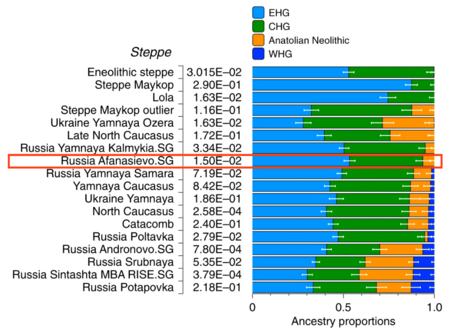
Because the Afanasievo people used metal, horses, and wheeled vehicles, many scholars believe they spoke an Indo-European language. They were genetically very similar to the Yamnaya people. Later, other cultures replaced the Afanasievo people in Siberia.
Some experts think the Afanasievo culture might have brought metalworking to China. They might have had contact with cultures like the Majiayao culture and the Qijia culture. This could have helped spread bronze technology. There might also have been influences from early Chinese cultures on Afanasievo pottery.
What Came Next
In the Altai Mountains, the Afanasievo people might have lived alongside the early Chemurchek culture for a while. Some of their burial items are similar.
To the north, the Afanasievo culture was followed by the Okunev culture. This culture was different, but it still showed some influences from the Afanasievo people. Later, other cultures like the Andronovo culture and Tagar culture lived in the region.
Genetic studies confirm that the Afanasievo culture was replaced by new groups. These new groups came from the Andronovo culture during the late Bronze Age.
Many scholars suggest that the Afanasievo culture were the ancestors of the Tocharians. The Tocharians lived near the Tarim Basin (in modern Xinjiang, China) much later. Their languages are now extinct.
Shirenzigou Culture (410-190 BCE)
Genetic studies of people from the Shirenzigou culture show a mix of West Eurasian and East Eurasian genes. The West Eurasian part was linked to the Yamnaya people. This suggests that the Shirenzigou people might have come from the Afanasievo culture. They likely spoke an Indo-European language. This idea supports the link between Afanasievo and the Tocharians.
See Also
- Prehistoric Mongolia
- Yamnaya culture
- Tocharian languages





